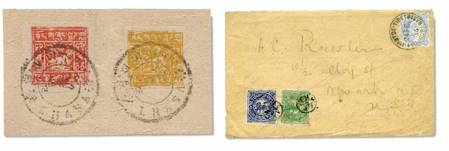thinking that many Western explorers who had failed to reach Lhasa would have highly prized a document like this.” [46]
Since 1912 passports were also issued to Tibetans leaving for foreign countries. [47] The first modern Tibetan passport [48] with personal information, photograph and space for visas and endorsements was issued in 1948 to members of the Tibetan trade mission. It was modeled on the international one-page fold-out model of 1915. Britain, the USA and seven other countries issued visas and transit visas for this document.
TREATIES

Treaty Pillar of 821-22 AD
One of the most important treaties between the Tibetan Empire and the Chinese Empire (concluded after a decisive Tibetan military victory) dates back to AD 821-822. The text, in Tibetan and Chinese was engraved on three stone pillars (
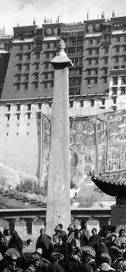
Shol Doring
Another article regarding the frontier (near the present Gansu-Shaanxi border) makes clear that “All to the East is the country of Great China; and all to the West is, without question, the country of Great Tibet.” [50]
This treaty pillar is sometimes mistaken for the more eye-catching Shol
As an independent nation, Tibet entered into treaties with neighboring states: Bushair 1681, Ladakh 1683 and 1842, Nepal 1856 and so on.
Tibet signed a number of treaties and conventions with Britain culminating in the Simla Treaty of 1914 by which British India and Tibet reached an agreement on their common frontier. [51] India ’s present-day claims to the demarcation of its northern border (the McMahon Line) is based on this treaty which was signed by independent Tibet – not China.
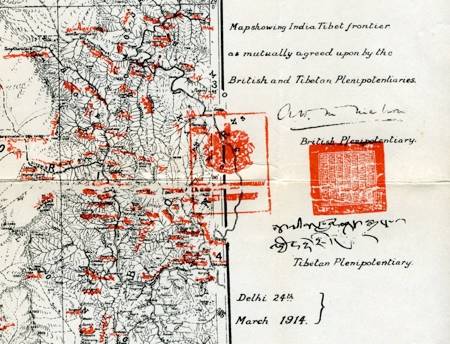
In January 1913, Tibet and Mongolia signed a treaty in Urga, the preamble of which reads: “Whereas Mongolia and Tibet having freed themselves from the Manchu dynasty and separated themselves from China, have become independent states, and whereas the two States have always professed one and the same religion, and to the end that their ancient mutual friendships may be strengthened…” [52] Declarations of friendship, mutual aid, Buddhist fraternity, and mutual trade etc., follow in the various articles. The Tibetan word “rangzen” is used throughout to mean “independence”.
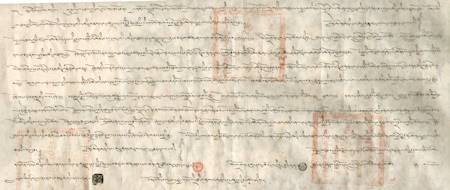
Mongolian Tibet Treaty of 1913
FOREIGN RELATIONS
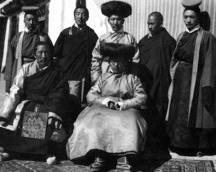
Foreign Bureau personnel
A Bureau of Foreign Affairs was established in 1909 [53] after the 13th Dalai Lama returned to Lhasa from Peking, and the Tibetan people, in symbolic rejection of Manchu rule, presented him with a new national seal. [54] The Foreign Bureau appears to have been reconstituted in 1941. [55] It conducted diplomatic relations with Britain, USA, Nepal, independent India and China. Nepal set up its legation in Lhasa in 1856, China in 1934 and Britain in 1936. Foreign ministry officials represented Tibet as an independent nation in the Inter-Asian Relations Conference convened in India March 23, 1947 to assess the status of Asia in the period following WWII. Tibet was also represented at the Afro-Asian Conference in 1948. Many participating nations were yet to be decolonized making Tibet one of the few established independent nations in that early pan-Asian gathering. [56]
A letter from the Foreign Bureau dated 2nd Nov 1949, to “Mr. Mautsetung”, describes Tibet as a religious nation, independent from “earliest times”, and requests the Communist leader to “issue strict orders” to his officers not to cross into Tibetan territory. Regarding Tibetan territory earlier annexed by China the letter states that “…the Tibetan government would like to open negotiations after the settlement of the Chinese Civil War.” [57]
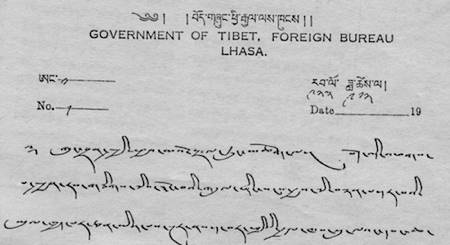
Foreign Bureau letter to Mao Tsetung
NEUTRALITY IN WORLD WAR II
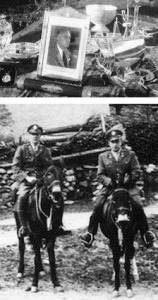
President Roosevelt’s envoys and gifts (above) to the Dalai Lama
Tibet was a declared neutral country (
POST & TELEGRAPH SYSTEM
The modern Tibetan postal service was built on courier systems used during the early Tibetan Empire and later Mongol Imperial rule. A “pony express” (
